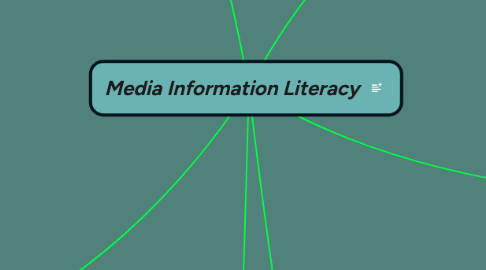
1. lesson 1: what is Media?
1.1. Media
1.1.1. This is how the information is spread. This is also how the communication process works. A massage is passed on to others with the help of tools and devices.
1.2. The Communication Process
1.2.1. The simplest and perhaps the oldest model is the Shannon-weaver model of communication that shows a linear type of communication process. This means that we follow a straight line of sending a message from one point to another.
1.3. The Feedback Mechanism
1.3.1. Developing the Shannon-weaver, other communication theorists like David Berlo were able to add receiver's which is sent back to the sender of the message.
1.4. Kinds of Media
1.4.1. Examples are News papers, Radio,Tv, Smartphones, Watching movies or DvD players.
1.5. Traditional Media
1.5.1. This includes all kinds of written or print media like newspapers and magazines.
1.5.1.1. Brocast media
1.5.1.1.1. Pertains to electronic media that uses electricity and technology to deliver the message or information.
1.5.1.2. Film or Cinema
1.5.1.2.1. Pertains to the movie that carry audiovisual messages and are usually projected onto a huge screen in theaters or movie houses.
1.6. New Media
1.6.1. Prefers to a different or newer way of creating processing, and transmitting information that is also similar to traditional media.
1.7. Social Media
1.7.1. Refers to Internet - maintained computer programs that could be installed in personal computers or portable devices, the sole purpose of which is to connect with other people using the same platform.
2. lesson 2: Media Then and Now
2.1. Brief History of Media
2.1.1. This is to convey information they want to share and get the information they also need.
2.2. Pre Industrial Age
2.2.1. This first form of mass media production revolutionized the way Europe and the western civilization developed. Spreading towards other parts of the world.
2.2.1.1. • Cave paintings
2.2.1.2. • Clay tablets
2.2.1.3. • Papyrus in Egypt
2.3. Industrial Age
2.3.1. This age clearly saw the active role of technology in advancing the way we communicate and disseminate information.
2.3.1.1. • Printing press for mass production
2.3.1.2. • Newspapers
2.3.1.3. • Typewriter
2.4. Electronic Age
2.4.1. This was first evident upon the utilization of the telegraph. Since the transfer of information from one point to another became fast and instantaneous.
2.4.1.1. • Transistor Radio
2.4.1.2. • Television
2.4.1.3. • Large electronic computers
2.5. Digital Age
2.5.1. Refers to our current age wherein information is still seen as a commodity yet its mode of recording, storage, delivery and playback relies heavily on digital technology.
3. lesson 3: Understanding Media: Aesthetics of the Image, Text and Audio
3.1. framing and Reading
3.1.1. To construct, compose or imagine something. Meaning to create with solid plan to follow using a specific structure in mind.
3.2. Newspaper and Journalism
3.2.1. NEWS is defined as "The communication of information on current events print, Internet or word of mouth to a third party or mass audience.
3.2.2. JOURNALISM is defined as "The collecting, writing, editing and presenting of news in the world.
3.3. Books, Comics, Magazines and the Publishing Industry
3.3.1. Readers from all walks of life and from varying ages have their different favorites like the said types of books and it continuous to prints this kinds to suit the needs and demands of different sectors.
3.4. Photography and Timeless Image Concepts
3.4.1. "The process of recording images through a chemical interaction caused by light rays hitting a sensitized surface"
3.5. Radio and Evoking Imagination
3.5.1. It is the powerful since the broadcast could reach a wide array of areas, covering many household and reaching many individuals at a given time.
4. lesson 4: Understanding Media: Aesthetics of Film and Tv
4.1. The Film Form
4.1.1. SHORT FILM - A total running time will not exceed to one hour.
4.1.2. FULL-LENGTH FILM - It exceeds one hour and last up to two to three hours.
4.2. Modes of Film Production
4.2.1. The first mode is preproduction. Where all the planning stages of a film are made before actually making the film.
5. lesson 5: Understanding Media: Aesthetics of New Media
5.1. Deconstruction New Media
5.1.1. Technology usually encompass two form: the web-based applications or those you access by going online with laptops or desktop computers.
5.2. New Media Technology: Converge and Characteristics
5.2.1. The old-fashioned equipment used in the filmmaking has to be updated to make editing and transferring files easier.
5.3. New Media as Multimedia
5.3.1. Multimedia originally pertained to the way a single media product could contain several form of media content.
5.4. New Media Transition: from Synergy to Transmedia
5.4.1. Is a Big media corporation who run a media industries for profit, always try to find ways of making more money out of existing media content.
6. lesson 6: Understanding Media: Aesthetics of Social Networking
6.1. Deeper Understanding of Social Media
6.1.1. Proper using of social media to keep us safe and avoid getting hurt in real life situation.
6.2. What is Social Networkoing
6.2.1. "A supportive system sharing information and services among individuals and groups having a common interest."
6.3. Kinds of Social Media and its Varying Uses
6.3.1. They locate people they know in the platform and add them up as friends and contacts also give a chance for strangers to link up with each other become virtual/online friends.
6.4. Print-based
6.4.1. • Information
6.4.2. • Blogs
6.4.3. • Articles
6.5. Audio-based
6.5.1. • Spotify
6.5.2. • Radio stations
6.5.3. • Playlist songs
6.6. Photo-based
6.6.1. • Instagram
6.6.2. • taking Photo and manipulate them using installed filters and photo enhancers
6.6.3. • "Self-portraits" to "Selfie"
6.7. Video-based
6.7.1. • Youtube
6.7.2. • Vines
6.7.3. • Vimeo - Where you can add contacts in your friends to see thier video or interact with them in the platform.
6.8. Social Networking Sites
6.8.1. • Sites where you can sign up, post your pictures and share information
6.8.2. • Seeing what's happening everyday
6.8.3. • News around the world
